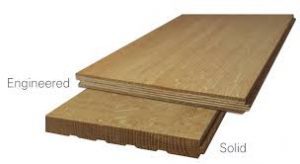 We are often asked by customers, “which floor should we use, engineered or solid flooring?” And every time the answer is the same, engineered flooring. There a few reasons why we would promote an engineered floor over a solid floor, the main points are listed below.
We are often asked by customers, “which floor should we use, engineered or solid flooring?” And every time the answer is the same, engineered flooring. There a few reasons why we would promote an engineered floor over a solid floor, the main points are listed below.
Acclimatisation.
Typically, a solid floor will need to be left in the property for 14 days before it can be installed. And engineered floor only requires 72 hours.
Stability.
An engineered floor is far more stable than a solid floor. Engineered floors can be installed in a variety of ways. They can be floated on a suitable underlay, glued directly to a suitable subfloor and secret screwed/nailed to timber joists or a timber subfloor.
Underfloor heating.
Due to its construction, engineered flooring is designed to be used on underfloor heating systems. There are certain parameters you must adhere to, but generally, your ufh system and your engineered floor should work in harmony together, to ensure a lifetime of comfort and warmth in your home.
There are two types of engineered flooring, overlay & load bearing.
Overlay floors are generally 14mm, 15mm or 16mm in depth. They are designed to be used over a solid subfloor which can be either concrete/screed or timber, such as plywood or chipboard. These floors will typically have a 3 or 4mm wear layer of hardwood, glued to the plywood backing.
Load bearing floors are generally 18mm – 21mm in depth. These are designed to be fixed to timber joists. You can use load bearing floors over solid subfloors but you are paying for a lot of product that you do not actually need. The floor will have a 5 or 6mm wear layer of hardwood, glued to the plywood backing.
A lot of clients voice concerns over the thickness of the wear layer on overlay floors, especially when comparing it to the load bearing version. In reality a floor with a 3mm wear layer should last you decades, provided it is clean and maintained with the correct products. If for some reason your floor is looking tired and worn, you should be able to sand off the floor and re finish it, giving you a new floor. This sanding process, if carried out by professionals will only remove between 0.5-1mm of the wear layer.
If you have underfloor heating, the other thing to consider between overlay and load bearing floors is thermal resistance. Wood is an insulator and therefore the more wood present, the longer it takes for heat to transfer through your floor and into your room. It makes sense, where possible to use the overlay version.
These are just some of the benefits of using and engineered floor instead of a solid floor. Visit one of our showrooms and talk to our staff for further information.





